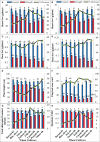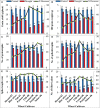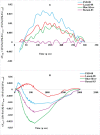Photosynthetic activity and metabolic profiling of bread wheat cultivars contrasting in drought tolerance
- PMID: 36844078
- PMCID: PMC9945586
- DOI: 10.3389/fpls.2023.1123080
Photosynthetic activity and metabolic profiling of bread wheat cultivars contrasting in drought tolerance
Abstract
The rapid increase in population growth under changing climatic conditions causes drought stress, threatening world food security. The identification of physiological and biochemical traits acting as yield-limiting factors in diverse germplasm is pre-requisite for genetic improvement under water-deficit conditions. The major aim of the present study was the identification of drought-tolerant wheat cultivars with a novel source of drought tolerance from local wheat germplasm. The study was conducted to screen 40 local wheat cultivars against drought stress at different growth stages. Barani-83, Blue Silver, Pak-81, and Pasban-90 containing shoot and root fresh weight >60% of control and shoot and root dry weight >80% and 70% of control, respectively, P (% of control >80 in shoot and >88 in root), K+ (>85% of control), and quantum yield of PSII > 90% of control under polyethylene glycol (PEG)-induced drought stress at seedling stage can be considered as tolerant, while more reduction in these parameters make FSD-08, Lasani-08, Punjab-96, and Sahar-06 as drought-sensitive cultivars. FSD-08 and Lasani-08 could not maintain growth and yield due to protoplasmic dehydration, decreased turgidity, cell enlargement, and cell division due to drought treatment at adult growth stage. Stability of leaf chlorophyll content (<20% decrease) reflects photosynthetic efficiency of tolerant cultivars, while ~30 µmol/g fwt concentration of proline, 100%-200% increase in free amino acids, and ~50% increase in accumulation of soluble sugars were associated with maintaining leaf water status by osmotic adjustment. Raw OJIP chlorophyll fluorescence curves revealed a decrease in fluorescence at O, J, I, and P steps in sensitive genotypes FSD-08 and Lasani-08, showing greater damage to photosynthetic machinery and greater decrease in JIP test parameters, performance index (PIABS), maximum quantum yield (Fv/Fm) associated with increase in Vj, absorption (ABS/RC), and dissipation per reaction center (DIo/RC) while a decrease in electron transport per reaction center (ETo/RC). During the present study, differential modifications in morpho-physiological, biochemical, and photosynthetic attributes that alleviate the damaging effects of drought stress in locally grown wheat cultivars were analyzed. Selected tolerant cultivars could be explored in various breeding programs to produce new wheat genotypes with adaptive traits to withstand water stress.
Keywords: Triticum aestivum; chlorophyll fluorescence; drought stress; mineral nutrients; osmotic adjustment; water relations.
Copyright © 2023 Ghaffar, Hussain, Ajaj, Shahin, Bano, Javed, Khalid, Yasmin, Shah, Zaheer, Iqbal, Zafar and Athar.
Conflict of interest statement
The authors declare that the research was conducted in the absence of any commercial or financial relationships that could be construed as a potential conflict of interest.
Figures










Similar articles
-
Linking changes in chlorophyll a fluorescence with drought stress susceptibility in mung bean [Vigna radiata (L.) Wilczek].Physiol Plant. 2021 Jun;172(2):1244-1254. doi: 10.1111/ppl.13327. Epub 2021 Jan 18. Physiol Plant. 2021. PMID: 33421155
-
Role of mineral nutrients, antioxidants, osmotic adjustment and PSII stability in salt tolerance of contrasting wheat genotypes.Sci Rep. 2022 Jul 25;12(1):12677. doi: 10.1038/s41598-022-16922-9. Sci Rep. 2022. PMID: 35879515 Free PMC article.
-
Genetic Potential and Inheritance Patterns of Physiological, Agronomic and Quality Traits in Bread Wheat under Normal and Water Deficit Conditions.Plants (Basel). 2022 Mar 31;11(7):952. doi: 10.3390/plants11070952. Plants (Basel). 2022. PMID: 35406932 Free PMC article.
-
Genetic Improvement of Wheat for Drought Tolerance: Progress, Challenges and Opportunities.Plants (Basel). 2022 May 18;11(10):1331. doi: 10.3390/plants11101331. Plants (Basel). 2022. PMID: 35631756 Free PMC article. Review.
-
Nutrient management: as a panacea to improve the caryopsis quality and yield potential of durum wheat (Triticum turgidum L.) under the changing climatic conditions.Front Plant Sci. 2023 Aug 28;14:1232675. doi: 10.3389/fpls.2023.1232675. eCollection 2023. Front Plant Sci. 2023. PMID: 37701803 Free PMC article. Review.
Cited by
-
Multi-Trait Index-Based Selection of Drought Tolerant Wheat: Physiological and Biochemical Profiling.Plants (Basel). 2024 Dec 26;14(1):35. doi: 10.3390/plants14010035. Plants (Basel). 2024. PMID: 39795295 Free PMC article.
-
Response mechanism of water status and photosynthetic characteristics of Cotoneaster multiflorus under drought stress and rehydrated conditions.Front Plant Sci. 2025 Jan 14;15:1457955. doi: 10.3389/fpls.2024.1457955. eCollection 2024. Front Plant Sci. 2025. PMID: 39877737 Free PMC article.
-
Photosynthetic responses of heat-stressed apple leaves to foliar application of salicylic and ascorbic acid.Photosynthetica. 2024 Feb 5;62(1):79-89. doi: 10.32615/ps.2024.006. eCollection 2024. Photosynthetica. 2024. PMID: 39650632 Free PMC article.
-
Studies on the Physiological Response of Hemerocallis middendorffii to Two Types of Drought Stresses.Int J Mol Sci. 2024 Dec 23;25(24):13733. doi: 10.3390/ijms252413733. Int J Mol Sci. 2024. PMID: 39769494 Free PMC article.
References
-
- Abedi T., Pakniyat H. (2010). Antioxidant enzymes changes in response to drought stress in ten cultivars of oilseed rape (Brassica napus l.). Czech J. Genet. Plant Breed. 46, 27–34. doi: 10.17221/67/2009-CJGPB - DOI
-
- Ahmad A., Aslam Z., Javed T., Hussain S., Raza A., Shabbir R., et al. . (2022). Screening of wheat (Triticum aestivum l.) genotypes for drought tolerance through agronomic and physiological response. Agronomy 12, 287. doi: 10.3390/agronomy12020287 - DOI
-
- Allen S., Dobrenz A., Schonhorst M., Stoner J. (1985). Heritability of NaCl tolerance in germinating alfalfa seeds 1. Agron. J. 77, 99–101. doi: 10.2134/agronj1985.00021962007700010023x - DOI
-
- Ashraf M., Foolad M. R. (2007). Roles of glycine betaine and proline in improving plant abiotic stress resistance. Environ. Exp. Bot. 59, 206–216. doi: 10.1016/j.envexpbot.2005.12.006 - DOI
-
- Ashraf M., Foolad M. R. (2013). Crop breeding for salt tolerance in the era of molecular markers and marker-assisted selection. Plant Breed. 132, 10–20. doi: 10.1111/pbr.12000 - DOI
LinkOut - more resources
Full Text Sources
Research Materials
Miscellaneous

